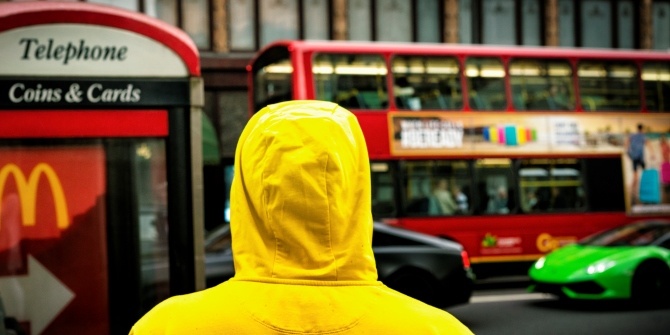In this piece, Alejandro Fernández explores the genre of science-fiction through Foucault’s concept of identification and communication between artist and spectator, with particular reference to JG Ballard’s novel High-Rise (1975).
“A mere confrontation, eyes catching one another’s glance, direct looks superimposing themselves upon one another as they cross. And yet this slender line of reciprocal visibility embraces a whole complex network of uncertainties, exchanges, and feints.” (Foucault: 1966 p.20)
Foucault refers to the gaze of Velázquez in the portrait “Las Meninas”. This painting depicts the artist himself working with the family of Felipe IV. In a baroque manner, the painter seems to be portraying the spectator instead of the Royal Family. Foucault described the gaze of Velázquez as an exercise of identification and communication between the artist and the spectator. Appealing pieces of art tell us something about who we are. Speculation can be one of the best the ways to capture a moment of society.
 Image Credit: (‘Las Meninas’ by Diego Velázquez located in Prado Museum, Madrid – Wikimedia Commons Public Domain)
Image Credit: (‘Las Meninas’ by Diego Velázquez located in Prado Museum, Madrid – Wikimedia Commons Public Domain)
The science-fiction genre is mostly assimilated to this realm. Novels and films are viewed as entertaining tales of decay or dystopic futures. JG Ballard’s novel High-Rise could be read in this manner. An elaborated lucubration on the possible decay of Western civilisation due to failing technology and moral decline.
Nevertheless, could it be possible to look at High-Rise as the faithful portrait of contemporary England? Doesn’t this novel tell us something about the 70’s Zeitgeist? Ballard inserts crisis in a familiar upper-class environment just in a moment when the world was experiencing the end of “Le Trent Glorieuses”. In fact, the oil crisis had hit Europe two years before High-Rise was published in 1975. Systemic economic changes affected Western economies and neoliberalism started to become the only solution.
High-Rise depicts the descent of a bourgeois community into chaos. When the well-designed facilities start failing, the neighbours organise themselves in tribes to fight each other. The animosity goes in crescendo, dogs get killed and children harassed. The safety of the homes disappears and barricades are built to reflect the social stratification of the inhabitants. High-Rise is the end of an era: “a temporary power failure had occurred, and on the 7th floor all the lights were out. Already torch-beams were moving about in the darkness, as the residents made their first confused attempts to discover where they were. Laing watched them contentedly ready to welcome them to their new World” (Ballard:2014 p.248). Laing, the main character, gazes across the window to the surrounding buildings as they follow the fate of the High-Rise. Laing looks at us.
The almighty modernist architecture seems to be the perfect setting for this to happen as Ben Weathly proves in his film adaptation (2015). There are some resemblances between the concrete of the High-Rise itself and Alexandra Road Estate. However, Ballard’s tenants are members of the upper classes, unlike “sink estate”[i] dwellers. Is Ballard making a statement about architecture or society? Are we all bound to technology or does class define us? Modernist architecture was the product of an era that saw the solution to social problems in regulation and provision. It is precisely this type of society, this welfare, which is in danger in Ballard’s novel. Uniformity and integrity leave place to dissidence, subversion and anti-social behaviour, to the other.
Widespread post-war identities around family and security give way to a more agonistic vision of reality, as Laing puts it: “it’s a mistake to imagine that we’re all moving towards a stage of happy primitivism. The model here seems to be less the noble savage than our un-innocent post-Freudian selves, outraged by all that over-indulgent toilet-training, dedicated breastfeeding and parental affection – obviously a more dangerous mix than anything our Victorian forebearers had to cope with. Our neighbours had happy childhoods to a man and still feel angry. Perhaps they resent never having had a chance to become perverse” (Ballard:2014 p.153).
This agonistic conception of society focuses on dissent and perversion. Individuals are freed from their responsibilities as fathers, professionals or wives. They come to integrate communities founded on physical proximity and openly re-define sexual behaviour. Couples are dissolved and rebuilt in non-monogamous relationships while hygiene and nutrition take new forms. This appropriation of daily life space is not a tale about a future decadence but of a mutable society in which mores and values are subject to change.
According to Lefebvre, representational spaces are “space as directly lived through its associated images and symbols, and hence the space of “inhabitants” and “users”, but also some artists and perhaps a few writers and philosophers, who describe and aspire to no more than describe; this is the dominated — and hence passively experienced — space which the imagination seeks to change and appropriate (Lefebvre: 1991 p.39).
High-Rise is the representational space of the changes that western society underwent in the 70s. The tale of a certitude lost. Ballard said in an interview “I see myself more as a kind of investigator, a scout who is sent on ahead to see if the water is drinkable or not” (Ballard: 2015 p.252). High-Rise is about middle-class fears and petit-bourgeois society facing dismembering. It is about failing technology and the rise of new values. Ballard was the first to peer at the economic recession, political crisis and social life that was to follow. The question for sociologists could then be to identify the traits that compose this reality.
References
Ballard. JG. (2014) [1975] High Rise. Fourth State: London.
Lefebvre. H. (1991) The Production of Space. Basil Blackwell: London.
Foucault, M. (1966) Les Mots et les Choses. Gallimard: Paris.
[i] In his estate regeneration announcement as Prime Minister (January 2016), David Cameron referred to the ‘so-called sink estates’, and the people living in them, needing to be managed and requiring social reform: https://www.gov.uk/government/speeches/estate-regeneration-article-by-david-cameron
Alejandro Fernández is a student on the MSc City Design and Social Science programme. His research interests include the intersection of art, policy and identity.





